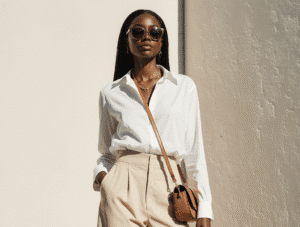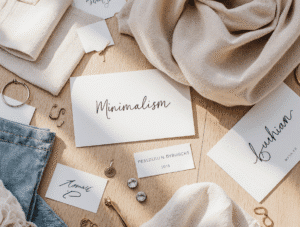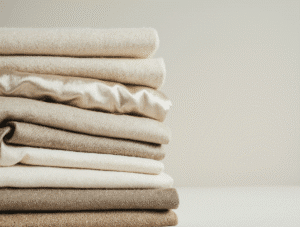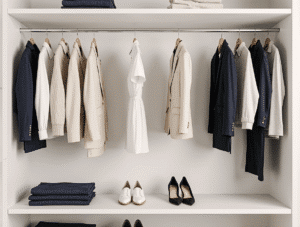Developing a unique fashion identity is more than choosing clothes. It is about self-expression, confidence, and comfort. Finding your personal style allows you to communicate who you are without words. Instead of chasing every fast-moving trend, you can build a wardrobe that feels authentic and makes everyday dressing easier. This expanded guide will help you discover your fashion voice, choose wisely, and create a closet that reflects your true personality.

1. Understand Your Fashion Preferences
Evaluate Your Current Wardrobe
Start by studying your closet with a critical eye. Notice what you wear most often and why. Do you prefer bold prints, calm neutrals, or a mix of both? Do you reach for structured jackets or soft oversized sweaters? Pay attention to how clothing feels on your body. Personally, I once noticed that my closet was filled with polyester. The fabrics looked cheap and never gave the elegant impression I wanted. After that realization, I decided to invest only in natural fibers. Such discoveries uncover the hidden patterns of your fashion choices.
Identify Your Style Icons
Think about the people whose style inspires you. It can be a celebrity, a designer, or even a friend. Study their outfits and note which details attract you. You might admire Audrey Hepburn’s timeless elegance, or Zendaya’s ability to mix classic and bold modern looks. Style icons serve as mirrors, helping you define your own preferences. Try to describe what exactly appeals to you: is it the simplicity of cuts, the way they accessorize, or their bold use of colors?
2. Gather Inspiration and Define Your Aesthetic
Create a Visual Mood Board
Collect images that resonate with you. Use Pinterest, Instagram, or fashion magazines. Pin outfits, accessories, and textures that excite you. After a while, you will see clear patterns: maybe minimalism, bohemian romance, vintage chic, or sporty casual. This collage becomes a map for your wardrobe.

Articulate Your Vision
Write down three to five adjectives that describe the style you want. For example: polished, feminine, natural. These words will guide your shopping. They also help you say “no” to items that do not fit your vision. Consistency leads to a coherent and authentic wardrobe. You can even create a short “style statement” that sums up your vision, such as: “I want a wardrobe that feels refined yet comfortable, rooted in natural fabrics and earthy tones.”
3. Dress for Your Lifestyle and Needs
Align Clothing with Daily Life
A wardrobe must reflect reality. If you work in an office, you need tailored pieces, blazers, and smart shoes. If your lifestyle is casual or creative, comfortable basics and versatile layers matter more. Ask yourself: what do I do each day? Where do I spend time? Clothing must serve your routines instead of fighting them. Write down the main categories of your week: work, leisure, family, social, fitness. This will show you how many outfits you need for each area of life.
Plan for Special Occasions
Life is full of events that need more than everyday clothes. Weddings, birthdays, business dinners — each requires something polished. Keep two or three outfits ready so you never panic. A cocktail dress, an elegant suit, or refined separates will save you time and stress. Consider accessories too: a neutral clutch or a classic tie can instantly elevate a simple look.
4. Identify Colors and Fabrics That Complement You
Discover Your Best Colors
Colors influence mood and perception. Try warm tones like terracotta, cool tones like navy, and neutrals like beige or gray. Observe which shades brighten your face and which make you look tired. Studies in psychology confirm that wearing flattering colors boosts self-esteem and social confidence. Some people even work with stylists to undergo a “seasonal color analysis” that defines whether they look best in spring, summer, autumn, or winter palettes.
Prioritize Comfortable Fabrics
Fabrics matter as much as design. Natural fibers breathe better, feel softer, and age gracefully. Here is a quick comparison:
| Fabric | Benefits | Drawbacks |
|---|---|---|
| Cotton | Breathable, versatile | Can wrinkle easily |
| Linen | Light, natural look | Creases quickly |
| Wool | Warm, durable | Can feel heavy |
| Silk | Luxurious, elegant | Needs delicate care |
| Polyester | Affordable, wrinkle-free |
Often looks less refined |

Choose fabrics that support comfort and elegance, not only trends. Over time, you will start to notice that investing in better fabrics leads to longer-lasting clothes and a more elevated appearance.
5. Build a Wardrobe Around Core Pieces

Invest in Timeless Essentials
Some garments never go out of style. They provide a strong foundation:
- Tailored blazer – adds structure and polish.
- White shirt – pairs with denim or suits.
- Perfect-fit jeans – casual yet smart.
- Little black dress (LBD) – always ready for evening wear.
- Quality knitwear – soft layers for every season.
- Versatile shoes – sneakers for everyday, boots or heels for formal events.
Once you secure these essentials, add statement pieces to express your personality. Accessories, jewelry, or scarves can transform basics into outfits that look new every time.
Regularly Audit Your Wardrobe
Twice a year, review your closet. Donate or sell items you no longer wear. This keeps your style focused and prevents clutter. You will also see which pieces you are missing. A wardrobe audit is like editing a book — it sharpens the story you want your clothes to tell.
6. Learn the Art of Layering
Layering is a secret tool of style. It creates depth and flexibility. Try a silk blouse under a wool blazer. Combine a chunky cardigan with a flowing skirt. Layering makes clothes adaptable to seasons and situations. It also shows creativity and individuality. In colder months, layering allows you to stay warm without losing elegance. In summer, lighter layering adds variety without heaviness.
7. Experiment, Refine, and Adapt
Style is not fixed forever. It grows with you. New jobs, travels, or life phases change how you want to dress. Do not fear experiments. Try a color you never wore. Mix sneakers with a formal skirt. If it feels right, keep it. If not, let it go. The process of finding your personal style is continuous and exciting. Write down what experiments worked and what did not. This reflection will save you from repeating mistakes and encourage successful choices.
8. Organize Your Wardrobe Thoughtfully
A messy closet hides your treasures. Keep it simple and functional. Group similar items together, use matching hangers, and store seasonal clothes separately. Good organization reduces decision fatigue. Each morning becomes faster and more enjoyable. Some people even arrange clothes by color or type, creating a mini boutique at home. This makes dressing a more inspiring experience.
9. Confidence Is the Key to Great Style 
At the end of the day, style is not about clothes alone. It is about how you wear them. Confidence transforms even the simplest outfit into a statement. Walk tall, smile, and own your choices. Research in social psychology shows that people perceive confidence as attractiveness. Believe in your style and others will too. Remember: your outfit is only as strong as the way you carry it.
10. Checklist: Steps Toward Finding Your Personal Style
- Analyze your current wardrobe.
- Eliminate fabrics or cuts that do not feel good.
- Identify three style icons.
- Create a mood board with 20–30 looks.
- Write down adjectives for your dream style.
- Build a foundation with timeless essentials.
- Experiment with colors and layering.
- Organize your wardrobe twice a year.
- Prepare two outfits for special occasions.
- Trust your confidence — it is your best accessory.
Finding your personal style is not about following fashion rules. It is about building harmony between who you are and what you wear. By analyzing preferences, gathering inspiration, choosing the right fabrics, and investing in essentials, you create a wardrobe that feels personal and empowering. Confidence ties it all together. Start today: open your closet, take notes, and begin shaping a style that will grow with you. Fashion is not static — it is an evolving language. The more attention you give to your style, the more fluent you become in expressing your authentic self.
How to Dress for Wedding: A Guide to Popular Dress Codes
Wardrobe Items That Make Your Outfit Look Cheap – And How to Upgrade Your Style
How Color Psychology Influences Your Outfit Choices
Detecting Early Signs of Hair Thinning: A Guide to Prevention and Treatment

I’m Victoria, the creator behind Eva My Balance. Passionate about beauty, wellness, sustainable living, and mindful self-care. My mission is to inspire you to live consciously and beautifully—inside and out.



